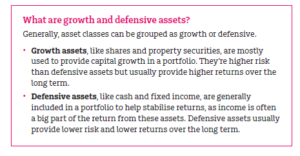How much you can afford to spend in retirement is determined by a number of different factors including investment markets, your super balance and lifestyle. But is there more you can do to help yourself have a better retirement? Understanding your expected spending patterns and ensuring you have an appropriate investment and drawdown strategy can help you determine whether you can support your desired retirement lifestyle.
One of the most important steps in your retirement planning is figuring out how much you’ll need to spend each year to support your desired retirement lifestyle. However, many people struggle to plan for the various stages of spending that they may require as they move through retirement.
Chart 1 shows how retirement spending can change over time. Many people spend a lot initially, supporting their new lifestyle, before settling into a simpler life. As we age, accommodation and medical costs tend to rise.
Chart 1: Typical spending during retirement
How much will you spend in retirement?
A few guidelines to help you work out your retirement spending budget include:
- Government regulations – the Superannuation Industry (Supervision) SIS regulations mandate minimum pension withdrawals, ranging from 4% pa for those aged under 65 through to 14% pa for ages 95+.1
- Association of Superannuation Funds of Australia Limited (ASFA) Retirement Standard – provides the annual budget benchmarks to fund either a ‘comfortable’ or ‘modest’ standard of living, for both singles and couples. It is updated quarterly to reflect changes to inflation, as measured by the Consumer Price Index (CPI).2
- Replacement Ratios – these measure your income in retirement relative to the income you earned during your working life. The benefit of these ratios is that they directly relate to the wealth and lifestyle that you enjoyed during your working life.
- Mercer Retirement Income Framework – this alternative framework recognises that in the earlier active stage of retirement (ages 65 – 74 years) the SIS minimum withdrawal rate may not be enough. It proposes a drawdown strategy where retirement income includes either a minimum threshold to cover ‘essentials’ or a target income level to afford ‘extras’.3
The importance of the investment strategy
There is generally a clear relationship between your desired level of spending, how much your savings are and the way in which the retirement savings are invested. This is referred to as a drawdown strategy.
In essence, a good drawdown strategy may require you to balance the following objectives:
- Sustain a stable and comfortable standard of living in retirement. Ideally similar to what you were accustomed to prior to retirement
- Maximise your Age Pension and any other potential social security benefits
- Protect the value of your savings against being eroded by inflation and adverse market conditions
- Provide you with access to your savings to pay for unplanned expenses (without significant penalties for early withdrawal of your capital), and
- Minimise the risk that you will outlive your wealth, at least for essentials.
And remember as we get older, it generally becomes harder to solve new problems and process new concepts meaning we often find we shy away from complex decision making.4 Therefore, it’s important to develop a drawdown strategy early that works for you, which accounts for this cognitive decline and that lets you easily change your investments as your needs change during retirement.
So what could this look like?
A 65-year-old retired couple has combined superannuation assets of $500,000 and want to make their savings last 25 years. Chart 2 shows the impact of different spending strategies for two of the most common account-based pension (ABP) investment portfolio options – conservative and balanced.
If the couple adopted a spending strategy of $50,000 per year, they have at least a 90% likelihood of success for both options (that is, their superannuation assets lasting at least 25 years).
Alternatively, if they spend $56,000 annually, the likelihood of success drops to 56% with the balanced option and 38% with the conservative option. The balanced option has a higher likelihood of success, due to its larger allocation to growth assets. This increases the portfolio’s expected level of both long-term returns and risk. In contrast, the conservative option is made up of more defensive assets.
Chart 2: Impact of spending strategy and investment option on likelihood of super lasting to age 90
Note: Includes the couple’s hypothetical Age Pension entitlement. Results reflect the superannuation and Government Age Pension rules applicable from 1 July 2017.
Source: Willis Towers Watson.
What can I do now to help achieve my desired retirement lifestyle?
It’s important to have a spending and investment strategy in place that is flexible enough to respond to a variety of factors and risks, including the changing patterns of your retirement income needs. Unexpected lump sum expenses, external influences on retirement savings (eg adverse market movements) and regulatory changes (eg variations to Age Pension and superannuation rules) must be considered.
It’s also good to have a trusted financial adviser or family member who understands your drawdown strategy, and can help you to make decisions about your investments in the future.
————————————————————————————————————————————-
- Schedule 7, Superannuation Industry (Supervision) Regulations, 1994.
- ‘ASFA Retirement Standard’, December 2016.
- ‘Retirement Income – A framework for a complex problem’, Mercer, 2015.
- Kulatunga. K., ‘Five investment barriers to recognise if you’re over 55’, NAB Asset Management, 2016.
Important information
All reasonable care has been taken in producing this communication. Subsequent changes in circumstances may occur and impact on its accuracy. Any opinions expressed in this communication constitute our judgement at the time of issue and are subject to change. We believe that the information contained in this communication is correct and that any estimates, opinions, conclusions or recommendations are reasonably held or made at the time of compilation.
However, no warranty is made as to their accuracy or reliability (which may change without notice) or other information contained in this communication.
Any projection or other forward looking statement (‘Projection’) in this document is provided for information purposes only. No representation is made as to the accuracy of any such Projection or that it will be met. Actual events may vary materially. MLCI relies on third parties to provide certain information and is not responsible for its accuracy.
MLCI is not liable for any loss arising from any person relying on information provided by third parties.
This article is directed to and prepared for Australian residents only.



